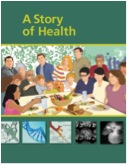New! A Story of Health Illustrated Multimedia eBook
 One in ten children has asthma. . . One in six children has a developmental disability. . . Although still rare, childhood leukemia has increased by 55% over the past 35 years. . .
One in ten children has asthma. . . One in six children has a developmental disability. . . Although still rare, childhood leukemia has increased by 55% over the past 35 years. . .
There is accumulating evidence that environmental factors contribute to the overall risk of many childhood diseases, including asthma and leukemia. In many people, at current levels of exposure, pesticides, tobacco smoke, and traffic-related air pollution are just some of the environmental agents associated with important health impacts, suggesting yet another reason to strengthen regulatory programs aimed at reducing harmful exposures.
Too often our focus is on a cure rather than prevention. Preventing disease and promoting health require a comprehensive approach and commitments at the individual, family, community, and societal levels. An ecological approach to health recognizes the nested and interwoven relationships that exist between the health of an individual and the surrounding environment. Storytelling is one way to express the interactions between multiple layers of health, and has been found to be a powerful way to learn.
A Story of Health multimedia eBook explores the complicated answers behind how or why a person get’s sick or develops a disability. The eBook delves into how our environments interact with our genes to influence health across the lifespan, told through the lives of fictional characters and their families - Brett, a young boy with asthma; Amelia, a teenager with developmental disabilities; and toddler Stephen, recently diagnosed with leukemia. Each fictional case focuses on real risk factors and features the latest scientific research about disease origin and helpful facts about disease prevention.
A Story of Health examines how a wide range of factors have an impact on our health every day, including the air we breathe, the water we drink, the food we eat and our social and economic circumstances. For example:
- Discover how early life stress can magnify the effects of exposure to air pollution and make asthma worse.
- See how some genes can make children more susceptible to toxic substances like pesticides, which may contribute to the onset of development disabilities.
- Learn how a common nutritional supplement can reduce the risk of childhood leukemia and other disorders.
We are learning more and more about the importance of early-life experiences on health, particularly during critical windows of development of a child. The beneficial or detrimental effects can be lifelong. What are some of the opportunities for avoidance and prevention to help reduce these risks in a child? Turning to the health of our environment may help mitigate these risks more than we know.
Access and download A Story of Health eBook today!
Go to the Collaborative on Health and the Environment to listen to the
January 22 teleconference on “Stephen’s Story” featured in A Story of Health.
For more information: Maria Valenti, Collaborative on Health and the Environment - mvalenti@igc.org Brian Tencza – Agency for Toxic Substances and Disease Registry - bht1@cdc.gov
– More on A Story of Health –
Colorful illustrations, graphics, and videos enhance each page. Pop-ups with essential “key-concepts,” links to a wide range of additional resources and hundreds of scientific papers enrich each story with information you can use today to promote health and prevent disease. A Story of Health includes multiple levels of detail useful to readers ranging from health professionals to health advocates, from policymakers to those working in the health and science media.
The eBook offers FREE continuing education credits through the Centers for Disease Control and Prevention (CDC)/the Agency for Toxic Substances and Disease Registry (ATSDR).
A Story of Health was developed by ATSDR, the Collaborative on Health and the Environment (CHE), the Office of Environmental Health Hazard Assessment, California EPA (OEHHA), the Science and Environmental Health Network (SEHN), and the University of California, San Francisco, Pediatric Environmental Health Specialty Unit (UCSF PEHSU).

